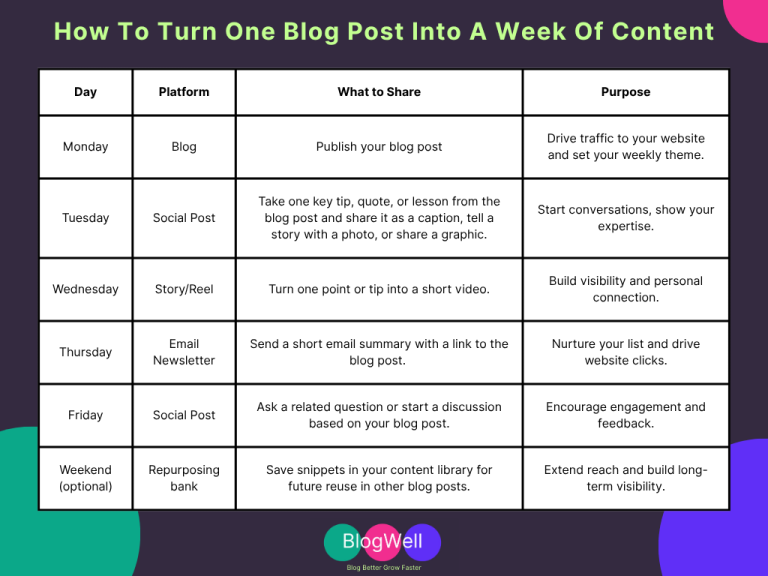How To Turn One Blog Post Into A Week of Content
Imagine if you only needed to write one blog post and that was your whole content sorted for the week. Socials, emails, videos, everything you needed to connect with your audience and help promote your business. All from that one blog post. Sounds like the dream, right?
Well, in this post, I’m going to show you how to turn one blog post into a week of content, so you can create more impact without doubling your workload.
Yep, that’s right, there’ll be no more frantically scrabbling around on a Monday morning trying to figure out what you’re going to post that week. I am going to help transform your content strategy so it finally feels simple and sustainable.
Because you know what it’s like, you finally get around to writing a blog post, you hit publish… and then what? You might share a link to the post on your socials and then that’s it. You move onto writing the next one or you don’t publish another one for weeks.
And that’s a missed opportunity. The fact is you don’t need more content, you just need to learn how to turn one blog post into a week of content and then repeat the process. It’s that simple.
By the end of this post, you’ll have a simple blog marketing strategy that shows you exactly how to turn one blog post into a week of content you can repurpose across your business. Sound good? Let me show you how to do it.
Start With One Strong Blog Post
Churning out endless posts for the sake of it isn’t going to do your business any favours. You don’t need to become some frenzied content robot to bring people to your website, you just need to be yourself and most importantly sound like you.
And while we’re on the subject of robots, a quick note on AI. It can be an incredibly useful tool for supporting your content strategy e.g. helping you brainstorm ideas, proofread, or check structure, but it should never replace your own voice. If you want to know why, I’ve written a full post about it – Why You Should Never Use AI To Write Your Blog Posts.
You should focus instead on creating good-quality posts that have purpose and provide genuine value for your audience. For example, posts that answer their questions, solve their problems, and encourage connection in some way.
If your blog post answers a question your audience keeps asking, you’ve already got the foundation for a week’s worth of content right there. This makes it much easier when you’re learning how to turn one blog post into a week of content, because your topic naturally lends itself to reuse. So use that as your starting point.
Here are a few types of blog posts that work well with this strategy:
-
Evergreen topics – posts that stay relevant long after they’re published.
-
Educational ‘how-to’ posts – actionable, useful content your readers can apply straight away.
-
Problem-solving posts – those that address a common struggle or misconception.
If you’re not sure where to start, have a read of my post – How To Find Blog Post Ideas In Everyday Conversations. It’ll help you spot the kind of blog content ideas your audience are actually searching for and what they want to read.
Extract 3-5 Key Talking Points
So, how do you figure out whichparts of your blog post you can pull out and repurpose into other types of content?
This is where having a well-structured blog post really works in your favour. Because a blog post with clear subheadings, bullet points and lists has basically done most of the hard work for you.
Think of it like this:
- That subheading? That’s your next email theme.
- Those bullet points? Each one can become a short video tip.
- A list? Perfect for your next Reel or carousel post.
- That quote you shared? Turn it into a graphic for your next social post.
Every single paragraph in your blog post hides a treasure trove of ideas you can share with your audience. Allowing you to easily repurpose blog content for social media, emails, and more.
When you’re figuring out how to turn one blog post into a week of content, this step is where the magic lies. It’s all about spotting the small but powerful pieces of your post that can stand alone as new content.
When you read back through your blog, look out for:
-
Questions you’ve answered.
-
Tips or advice you’ve shared.
-
Insights or personal stories that your audience will relate to.
Those are your prime repurpose pieces. Take just 3-5 of those key points and use them as your weekly content themes.
Plan Your Week Of Content
Right, you’ve got your blog post, you’ve extracted the key learnings from it, now it’s time to get down to the nitty gritty of how to turn one blog post into a week of content.
The key to creating a sustainable weekly content plan is to keep it flexible and not be too strict with yourself. Remember this is only a guide. If you miss a day because something unexpected happens (because let’s be honest, life likes to throw us curveballs at times!) that’s totally fine.
The key to creating a sustainable weekly content plan is to keep it flexible and not be too strict with yourself. Remember, this is only a guide. If you miss a day because something unexpected happens (because, let’s be honest, life loves to throw us curveballs!), that’s totally fine.
This isn’t about sticking rigidly to a schedule or feeling bad when things don’t go perfectly. It’s about giving you a content strategy that works alongside your blogging schedule, bringing clarity, focus, and helping make your week run more smoothly.
To help you see how simple this can be, here’s an example weekly content calendar showing exactly how to turn one blog post into a week of content, without having to start from scratch each time.
You can adapt this plan to suit your own platforms or schedule, but the idea stays the same. Your blog post becomes the anchor for everything else you share.
And once you start planning in this way, you’ll spend far less time wondering what to post and more time showing up consistently where it matters most.
Save Time With Templates & Systems
Putting a weekly content plan in place will save you hours of time, but when you understand how to turn one blog post into a week of content, using templates and systems makes the process even easier.
Here are some of my go-to content creation tools:
-
-
Google Docs – for storing ideas.
-
Canva – to create templates for quick branded graphics.
-
Trello – for weekly content planning and keeping ttrack of what’s been published.
- Chat GPT – for brainstorming and structuring posts.
-
The more you reuse what you’ve already created, the less you’ll need to start from scratch each time. And as you get good at this and fall into a routine, you can start batch creating your content. This will help give you clarity over what you’re producing each month and will allow you to repurpose as you go.
The better your strategy, the smoother your blogging workflow, which means more time to focus on the other areas of your business.
Final Thoughts
Now you can see how to turn one blog post into a week of content, one thing becomes clear… without a simple, consistent blog strategy, none of this works.
You want your business to be more visible online, right? You want people to find you easily, to connect with you, and to understand what you do. But you don’t want it swallowing up time you don’t have or making it feel like you’ve become a slave to the social media algorithms!
Turning one blog post into a week of content isn’t about doing more, it’s about making what you already do go further. When you treat that one post as the foundation of your content strategy, everything else starts to make much more sense.
- Your messaging becomes clearer.
- Your content becomes more consistent.
- And your website becomes a true reflection of the value you bring.
Because consistency doesn’t come from creating more, it comes from making the most of what you’ve already got.
Got a question about blogging? Come join the BlogWell Facebook Group
Author Bio
Bex Stafferton is a blogger who started off writing her blog The Art of Healthy Living as a hobby when she was a stay at home mum and caring for her two young children. She now looks after 4 different blogs and is also one half of the Bex & Ben duo who help small business owners take control of their websites and content with in their OWN IT Membership.
Bex is on a mission to help teach businesses how having a blog on their website is a valuable marketing tool. Helping to build a strong online presence, grow an engaged audience, and increase sales.
When she’s not blogging, Bex spends her time hiking up mountains, trail running, cuddling her two cockapoos, and renovating her house in the woods.












